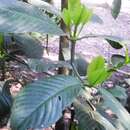en
names in breadcrumbs


This species is characterized by its long, robust peduncle and pedicel, large fruit, and by the plant exuding barely any yellow resin wherever cut. The Chinese plant (G. D. Tao 17879, Expedition for Drugs 6862) has 90-100 staminodes in the female flower. It is somewhat different from the descriptions of Anderson (in Hooker, Fl. Brit. India 1: 264. 1874) and Pierre (Fl. Forest. Cochinch. 1: xxiv, t. 79, M. 1883). We think it may be a local variant.
Garcinia pedunculata is an evergreen tree related to the purple mangosteen (Garcinia mangostana). The tree is endemic to the south-eastern regions of Asia such as parts of Myanmar, Bangladesh and north-eastern parts of India. It is popularly known in India as Amlavetasa, in Bangladesh as Thoikor or Taikor and in Assam as Bor Thekera.[1][2]
The tree has a fluted trunk with short spreading branches. Leaves are lanceolate with prominent midribs. Male flowers are light green in sparsely flowered panicles. The female flowers are solitary. The roundish fruit has a diameter ranging between 8 and 12 cm. It has a juicy interior with edible arils.[3]
The ripe fruit is eaten cooked or raw. Usually the ripe or raw fruits are sliced, sun-dried and preserved. In the state of Assam the fruit is used in cooking to add a sour flavour.
Garcinia pedunculata is an evergreen tree related to the purple mangosteen (Garcinia mangostana). The tree is endemic to the south-eastern regions of Asia such as parts of Myanmar, Bangladesh and north-eastern parts of India. It is popularly known in India as Amlavetasa, in Bangladesh as Thoikor or Taikor and in Assam as Bor Thekera.